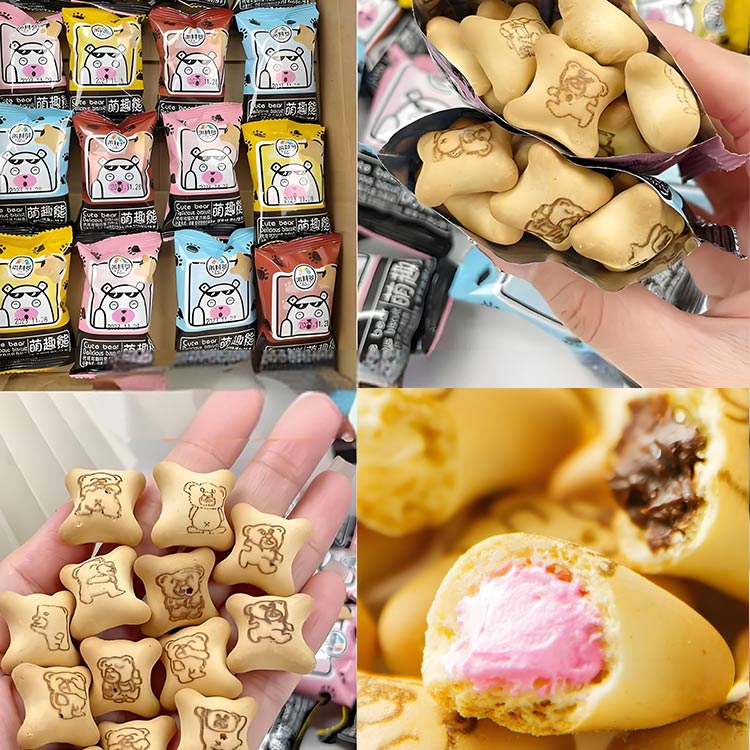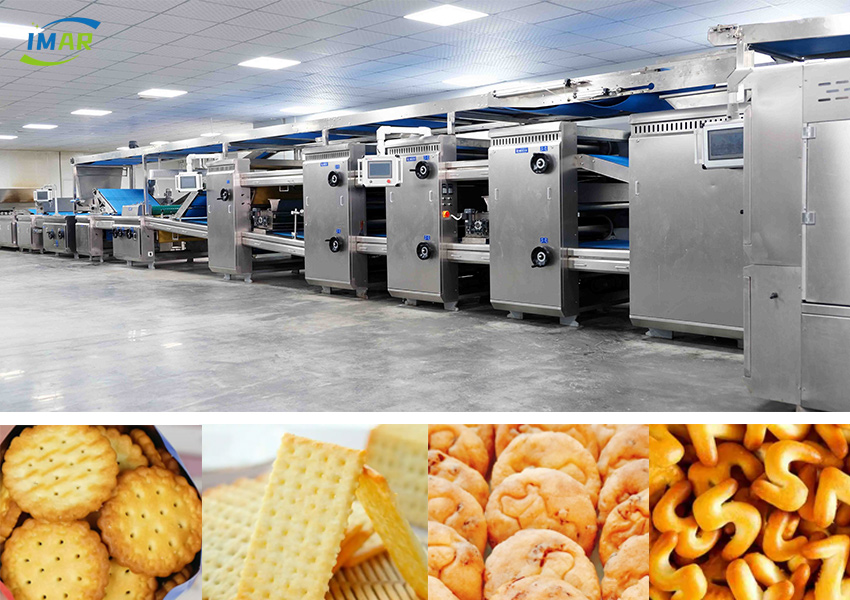In the competitive world of biscuit manufacturing, efficiency, consistency, and scalability are non-negotiable. Choosing the right automatic biscuit production line can make or break your business’s ability to meet market demands while maintaining quality and profitability. For companies considering an IMAR automatic biscuit production line—a leader in innovative food processing machinery—this decision requires careful evaluation of your unique operational needs, production goals, and long-term growth plans.
This blog will guide you through the key factors to consider when selecting an IMAR system, from understanding its cutting-edge automation features to aligning its capabilities with your factory’s output requirements. Whether you’re upgrading existing equipment or venturing into large-scale biscuit production, making an informed choice today can unlock transformative benefits for your business tomorrow. Let’s dive into how IMAR’s technology-driven solutions can elevate your production line to new heights.

**1. Project Specification**
The primary task for the Buyer is to define the products to be manufactured and the desired output (kg/h). The control and safety systems can be specified as PLC with HMI (Human-Machine Interface) or hard-wired panels. Other important initial considerations include factory space and available utilities, such as fuel (gas/oil), electricity, and compressed air.
The equipment specification should be detailed based on the Buyer’s requirements. Below is an example of the specification for a medium-sized biscuit line.
**2. Production Line Specification (750-1000 kg/h)**
**Product Specifications: English Biscuit**
– Diameter: 55.0 mm
– Thickness: 5.0 mm
– Weight: 7.5 g
– Appearance: Evenly blistered
– Texture: Light and crispy
– pH: 5.5
– Moisture Content: 1.5% – 2.0%
**Production Output**
– Oven Length: 50.0 m
– Oven Band Width: 1200 mm
– Output: 750-1000 kg/h
**1. Mixing and Dough Feeding**
1.1 **Horizontal Mixer**
– Horizontal high-speed mixer
– Stainless steel bowl with water jacket
– Dough temperature probe
– Direct discharge with a 150-degree bowl tilt
– Dual-speed or variable-speed drive (30/60 rpm)
– Ingredient feed ports for 2 dry and 2 liquid ingredients
– Safety guards and lock for the dough tub
– Controls for mixing times, speeds, and dough temperature
1.2 **Four Dough Tubs with Castors**
1.3 **Dough Feed Unit**
– Dough tub lift and tilt
– Live bottom hopper with dough guillotine
– Inclined web to feed dough pieces to the hopper of the three-roll sheeter
– Metal detector with reject system (optional)
**2. Biscuit Cutting Machine**
– Dough sheet width: 1200 mm
2.1 **Gauge Roll Sheeter**
– Roll diameters: 420 – 300 mm
– Variable speed drives for forcing roll and gauging rolls
– Dough scrap incorporation at the back of the sheeter hopper
– Delivery belt width: 1250 mm (synthetic material)
– Automatic tension and tracking
– Speeds and roll gaps set by machine-mounted HMI
2.2 **Two Gauge Roll Units**
– Rolls: 300 mm diameter
– Adjustable roll scrapers
– Delivery web with automatic tension and tracking
– Belt width: 1250 mm
– Speeds and roll gaps set by machine-mounted HMI
2.3 **Heavy-Duty Gauge Roll Unit**
– Rolls: 400 mm diameter
– Gauging gap: 0-8 mm
– Delivery web with automatic tension and tracking
– Belt width: 1250 mm
– Speeds and roll gaps set by machine-mounted HMI
2.4 **Rotary Cutting Machine**
– Suitable for separate printing and cutting rolls (200-300 mm diameter)
– Cutting conveyor belt with automatic tension and tracking
– Belt width: 1250 mm
– Speeds set by machine-mounted HMI
– Two rubber-covered rolls below the cutting conveyor to support printing and cutting operations
– Servo motor control of phasing between printing and cutting rolls
– Printing and cutting roll pressures adjustable
– Dough by-pass facility
– One printing and one cutting roll with plastic inserts for biscuits
2.5 **Transfer Conveyor**
– Conveyor belt with automatic tension and tracking
– Belt width: 1250 mm
– Speeds set by machine-mounted HMI
2.6 **Scrap Lift and Return System**
– Conveyor to pick up dough scrap with an adjustable nosepiece at the feed end
– Conveyor belt with automatic tension and tracking
– Dough scrap cutter
– Cross scrap conveyor
– Side scrap conveyor (300 mm wide) to deliver dough scrap to the three-roll sheeter
– Reciprocating delivery conveyor above the sheeter hopper to distribute scrap dough evenly across the hopper width
2.7 **Four Ambient Air Blowers** (fixed speed, also can be mounted over gauge rollers)
2.8 **Salt Sprinkler with Recovery**
– Stainless steel hopper
– Variable-speed sprinkler roll for salt with brush
– Wire mesh recovery conveyor
– Hopper to collect excess salt and deliver it to the side of the machine
2.9 **Rotary molder**
– Conveyor belt with automatic tension and tracking
– Belt width: 1250 mm
– Speeds and roll gaps set by machine-mounted HMI
– Unit supported on pivot; molder will rotary to follow oven band tracking movement guided by rollers engaging the sides of the oven band
– Facility to lift conveyor belt clear of the oven band
2.10 **Control System for Biscuit Cutting Machine**
– Cascade speed control by PLC
– Operator adjustment via HMI; roll gaps adjusted by servo motors with settings via HMI or by handwheels
**3. Direct Gas-Fired Baking Oven**
– Baking chamber: 50 m long, band width 1200 mm
– 4 zones: 10.0 m, 12.0 m, 14.0 m, 14.0 m
– Band pre-heat burners
**3.1 Oven Feed End**
– 1200 mm diameter drum with scraper
– Band tracking detection and pneumatic tracking system
– Pneumatic oven band tension system
– Oven band tension monitor
– 3.0 m drum center to baking chamber
**3.2 Direct Gas-Fired Baking Chamber**
– 4 zones with separate heat and humidity control
– Expansion joints between each zone
– Explosion relief panels in the oven top
– Inspection windows in each zone
– Clean-out doors on the non-control side, approximately 3.0 m apart
**3.3 Heat Rating**
– Fuel: LPG or LNG
– Maximum heat rating: 2000 kWh (33.3 kWh/m² of oven band)
**3.4 Gas Train**
– Manual shut-off valve
– Two automatic shut-off valves for the safety system
– Gas filter
– Zero gas pressure governor
– Gas pressure high/low detection
– Gas pressure gauges at the inlet and outlet of the gas train
– Gas valve tightness proving system (to check for gas leakage)
– Main gas pipes and distribution system
**3.5 Combustion Air Supply**
– 8 centrifugal blowers with 2.2 kW direct drives
– 8 air pressure gauges
– 8 motorized butterfly valves for top and bottom air pressure
– 8 pressure switches
– Braided air hoses between air header pipes and burners
– Note: Air pressure may alternatively be controlled by variable-speed blowers or motorized valves.
**3.6 Burner System**
– 106 burners with 1200 mm strips (18 with multi-lane control), including 6 pre-heat burners
– Turn-down ratio: 4/5:1
– Strip design and material: stainless steel corrugated strips
– 106 flame managers
– 106 gas/air mixers with gas/air ratio adjustment
– 106 solenoid valves
– 106 gas tube bends
**3.7 Ignition System**
– 106 electrode shields
– 106 tube igniters
– 106 mounting brackets
– 106 Rajah connectors
– Ignition cable
**3.8 Automatic Temperature Control**
– Four thermocouples are installed in each oven zone to detect baking temperatures. These provide signals to controllers at the zone control panels/PLC for temperature setting and monitoring with digital readouts.
– Combustion air pressure is modulated to maintain the set baking temperatures.
– Top and bottom burners in each zone are separately controlled.
**3.9 Extraction Fans**
– Four multi-vane forward-curved fans
– Volume: 34 m³/min
– Pressure: 70 mm WG at 20°C
– Four pressure switches for extraction fans
**3.10 Turbulence/Convection System (3 Zones)**
– Fixed-speed turbulence fans distribute convective air to ducts above and below the oven band.
– Turbulence ducts adjacent to return ducts to utilize heat from the return airflow to the burner.
– Even distribution of turbulence from full-width ducts running the length of the zones.
– Adjustment for top and bottom airflow.
**3.11 Over-Temperature Safety System**
– 1 thermocouple mounted in the extraction flue in each zone
– 1 Omron temperature controller to detect over-temperature and actuate the main gas shut-off valve
**3.12 Oven Delivery End and Drive Unit**
– 1000 mm drum unit
– 4000 mm extension from drum center to baking chamber
– Baking time adjustable from 3 to 9 minutes via variable speed AC motor with inverter control
– Adjustable stripper knife
– Wire mesh band stripping conveyor with adjustable discharge height and retractable nosepiece for biscuit reject
– Cross scrap conveyor for rejected biscuits
**3.13 Standby DC Drive or Standby Generator for Baking Band**
– In the event of a failure of the factory power supply, the drive will operate the oven band and stripping conveyor.
**3.14 Extraction Hood**
– A 2000 mm long stainless steel hood with an extraction fan mounted over the delivery end extension.
**3.15 Oven Band Cleaner**
– Top wire brush to clean the inside of the oven band, with a fixed speed drive
– Bottom wire brush unit to clean the outside of the oven band, mounted on a trolley for removal to the side of the oven
– Manual adjustment for brush pressure
**3.16 Oven Band**
– Type Z47 wire mesh band
– Width: 1200 mm
– Supported on skid bars in the baking chamber and on rollers on the return circuit
**3.17 One Set of Site Wiring Materials**
**4. Oil Spray System**
**4.1 Oil Spray Machine**
– Width: 1200 mm
– Stainless steel construction
– Stainless wire mesh conveyor with auto-tracking and tension
– Top and bottom spray units with spinning discs
– Mobile oil reservoir unit with heating
– High- and low-level sensors
– Filter system for surplus oil being returned to the reservoir
– Mist extraction system
**4.2 Drain Conveyor**
– Length: 2.0 m, Width: 1200 mm
– Stainless steel construction
– Stainless wire-mesh conveyor with auto-tracking and tension
– Drain system to a removable tank at the base of the conveyor

**5. Cooling Conveyors**
– Two-tier cooling system
– Arrangement to provide 150% of baking time, total length: 75 m
– Inclined conveyor to deliver crackers to the two-tier cooling system
– Stacker feed conveyor
– Pneumatic belt tensioning and tracking system
– 1300 mm wide synthetic webs
– AC motor gearboxes with inverter speed control
**6. Biscuit Stacking Machine**
– Chute with adjustable magnetic guides
– Adjustable star wheel stacking system
– Cracker guides for up to 20 lanes
**7. Packing Table**
– 1400 mm wide web
– Guides for up to 20 lanes
– Length: 12.0 m
– Automatic tension and tracking
– AC motor with inverter speed control
**8. Packing Machines**
8.1 Sandwich machine
8.2 Flow wrapping Machine
8.3 Metal detector
8.4 Boxing Station
Video of automatic biscuit production line:
By following the steps outlined above, both parties can develop a detailed and actionable biscuit production project. Throughout this process, the IMAR team will leverage our Biscuit Innovation Center to provide comprehensive support. Our own baking team will work closely with you to achieve your desired biscuit outcomes using our ovens in the innovation center. We can also enhance the flavor and taste of your biscuits based on our extensive experience and knowledge, and even share 1-2 our proprietary recipes if you plan to launch them in your market. Alternatively, you can provide us with a sample of the biscuit you aim to replicate or improve, and we will work towards achieving an even better result.



